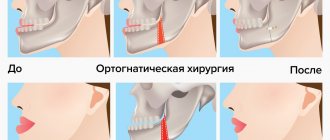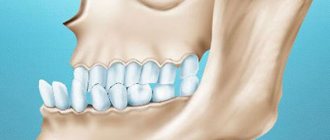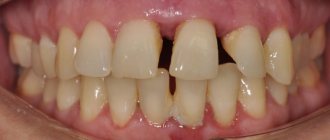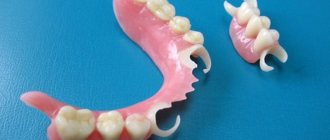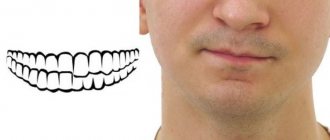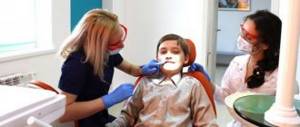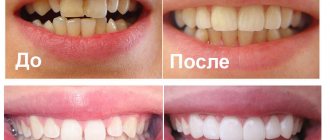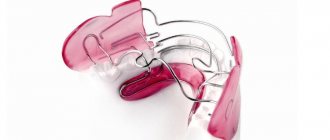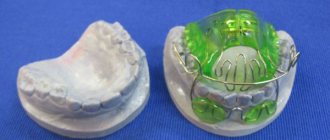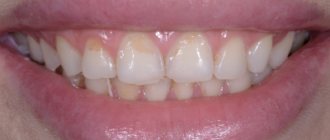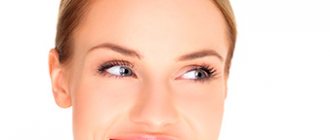One of the common orthodontic problems is open bite. With this type of malocclusion, the upper and lower dentition do not meet each other. When closing, a gap is formed between the jaws, which prevents the lips from closing normally and even chewing food. Most often I diagnose open bite in children under 12 months of age. Regardless of the cause of the pathology, it must be corrected. An open bite causes a person much more problems than other pathologies associated with occlusion.
Dental clinic PROPRIKUS provides services for correction of open bite. The procedure is performed by an orthodontist. Our clinic uses innovative correction techniques. We help get rid of bite problems, even in the most difficult situations. When drawing up a treatment plan, the patient’s age, degree of pathology, and dental condition are taken into account.
What is an open bite?
An open bite is a malposition of the dentition in which the front or lateral teeth of the upper and lower jaws do not meet. In this case, not only physiological disorders are observed, but also functional ones. Due to the lack of bite contact, a person cannot chew food well, as a result of which it enters other organs of the gastrointestinal tract in this form. This is why people with open bites often suffer from digestive problems.
This malocclusion can occur in both children and adults. In the absence of adequate treatment, its severity may worsen, and over the years it will become more and more difficult to correct it.
Frenkel apparatus
Having analyzed the state of the bite, Frenkel proposed correcting it by reducing the pressure of the lips and cheeks on the rows of teeth and alveolar processes. As a result of the applied action, the process of closing the lips was normalized and the position of the tongue assumed the correct position. The functions of the tongue also returned to normal.
In practice, the author brought the vestibular plate to the skeleton and introduced a metal frame into the structure. As a result, the strength of the structure increased and the drug became lighter. A positive feature of the Frenkel apparatus was the openness of the frontal area. This made it easy to swallow and speak correctly. The Frenkel apparatus has several types. For open bite, type 4 is used. It removes the influence of soft tissues on the proper development of the jaw and differs from other types in the following:
- The palatal arch is prepared for retrusion of the superior anterior teeth.
- Lip pads are placed in the lower part.
- The vestibular arch is used for the frontal upper teeth.
- The lateral sections of the dentition have metal linings.
- The device not only separates the bite, but also shortens it.
Causes
The causes of open bite can be divided into prenatal and postnatal. The first group includes the following:
- various unfavorable hereditary factors;
- infectious and somatic diseases suffered by the woman;
- bad habits and unbalanced diet of a pregnant woman;
- severe toxicosis.
All these factors can influence the process of bite formation in primary and permanent teeth. In this case, more serious concomitant pathologies may develop, such as cleft lip, deformation of the entire jaw, etc. Therefore, when identifying any malocclusion, it is important to conduct a comprehensive examination.
An open bite may develop in the postnatal period due to internal or external factors. In the first case, we are talking about a lack of certain microelements in the body, as well as a violation of metabolic processes.
Another common cause of malocclusion is that the child has problems with nasal breathing. In this regard, he begins to systematically breathe through his mouth, getting used to keeping it open. If parents notice such features, they should check the structure of the nasopharynx, especially the nasal septum, as soon as possible and begin treatment. Otherwise, the child may develop not only an open bite, but also other jaw pathologies.
The group of external factors includes the following:
- the child’s habit of biting nails or other foreign objects, for example, toys, pen caps, etc.;
- thumb sucking during the eruption of baby teeth;
- frequent protruding of the tongue between the teeth with the mouth open.
Often in these cases, the very form of the malocclusion begins to resemble the outline of the object that the child held in the mouth - a finger, a toy, etc.
Possible reasons
The disease can occur for the following reasons:
- Congenital disorders due to serious illnesses of the child's mother. These can confidently include heart disease, endocrine disorders, toxicosis, infections of various types, viral lesions and some other things.
- Bad heredity.
- Jaw injuries.
- Throwing back the head in sleep.
- Diseases of early age (for example, rickets).
- Improper breathing through the nose.
- The gap between the palate and the alveolar process.
- Increased size of the tongue and its improper functioning;
- Bad habits (biting objects, sucking fingers, holding the tongue in the gap from previously lost teeth, long-term habit of using a pacifier, biting nails).
- Atypical location of tooth germs.
Symptoms of an open bite
The main sign of an open bite is visible deformation of the dentition. In this case, the gap between the upper and lower jaws is clearly visible. It may be larger or smaller, but its presence is mandatory.
Often, children and adults with open bites experience changes in their facial features. Their chin becomes elongated or curved. The upper lip is usually slightly shortened, and the lower part of the upper dentition is visible from under it. To hide their underbite, such people often try to force their lips together without leaving a gap. However, for this they need to be kept in suspense all the time.
The front teeth of people with an open bite are often crowded. In this regard, they are more susceptible to caries, and therefore require additional monitoring.
There are also less pronounced symptoms of malocclusion. These include:
- frequent dry mouth, which occurs due to the predominance of mouth breathing over nasal breathing;
- difficulty biting and chewing food, which is especially noticeable in children with this disease;
- the appearance of periodontal disease and other concomitant diseases of the oral cavity.
Due to malocclusion, such people may experience a change in the shape of the bottom of the nose and upper palate, as well as pathology in the formation of the paranasal sinuses.
How does it manifest?
The pathology has pronounced symptoms, which are manifested by facial and intraoral changes.
Symptoms
The main symptoms of the disease include intraoral changes .
In addition to the vertical gap that forms between the teeth, other signs of pathology are observed:
- the frontal section of the jaw arch flattens and loses its roundness;
- narrowing of the jaw arches is determined;
- crowding of the lower jaw incisors;
- the lower jaw arch takes the shape of a trapezoid;
- lengthening the height of the lateral sections;
- the dentition has insufficient development of the apical bases;
- the teeth are irregularly shaped and arranged along a concave curve;
- Hypoplasia is observed on dental tissues;
- gingival papillae are hypertrophied;
- the tongue may be enlarged.
Facial features
During a facial examination, the following signs are revealed :
- the chin is displaced downward in relation to the angle of the lower jaw;
- the chin and nasolabial folds are smoothed;
- the upper lip is short and tense, making it difficult to close the lips;
- the lower half of the face is enlarged.
Functional disorders
Oral changes lead to disruption of certain functions :
- there are difficulties when biting and chewing food;
- diction is broken
- infantile swallowing is formed;
- mouth breathing predominates.
Pathogenesis of open bite
It should be remembered that an open bite can appear in the prenatal period. In this case, the incorrect position of the teeth begins in their rudiments. Therefore, they initially begin to grow crookedly.
Since the rudiments of molars are formed simultaneously with milk teeth, they can also have pathology. This is why in such cases it will not be enough to correct an open bite at an early age. In most cases, therapy will have to be repeated when permanent teeth erupt.
If the bite pathology is caused by external factors, then the formation process is somewhat different. In this case, the position of the dentition is initially correct, but over time it becomes deformed. It is important to notice such distortions in time and begin to correct them. Typically, the latter type of malocclusion is more amenable to treatment compared to congenital pathology.
What is this disease
Open bite - this occlusion disorder is characterized by the absence of complete closure of the lower and upper incisors. With it, pronounced pathological changes in the dental system occur with loss of function, as well as gross aesthetic defects. Such malocclusion can be an independent disease; it is also often combined with other pathologies of occlusion and uneven dentition. There are combinations with distal and mesial disruption of teeth closure. It is recorded quite rarely, its prevalence among all occlusion anomalies is about 2%. The defect is most often detected in children under one year of age.
Classification
According to the etiological criterion, such disocclusion is divided into true (rickets) and false (traumatic). There are three degrees of open bite; the classification is based on the amount of space between the upper and lower teeth, due to the lack of closure (occlusion).
Degrees of severity of occlusion violation:
- The first is that there is a vertical interdental space of up to five mm, with a lack of closure in the area of the anterior teeth (canines, incisors).
- Second, this stage is characterized by the presence of a vertical gap with a size of five to nine mm, with the absence of contact between the incisors of the canines and molars.
- Third - there is a space between the teeth measuring more than nine mm; the front teeth, molars, and premolars do not touch each other.
Based on location, frontal (front) and lateral forms are distinguished. Lateral is divided into bilateral and unilateral. It is noted that this pathology can be asymmetrical as well as symmetrical.
Causes
The reasons for the development of this pathology are quite diverse. They are divided into acquired and congenital factors.
Congenital causes of anomaly development include:
- unfavorable heredity for this trait;
- infections suffered during pregnancy;
- exogenous toxic effects on the fetus;
- somatic diseases of the mother;
- birth injuries;
- effect of medications;
- pregnant woman's injuries.
All these influences together during intrauterine development cause an atypical position of tooth germs, the formation of cleft palate, alveolar process and upper lip. Deformation of the facial skeleton occurs.
Acquired factors include:
- bad habits (prolonged use of a pacifier, sucking on foreign objects);
- consequences of rickets;
- hypovitaminosis;
- pathologies of mineral metabolism;
- early loss of primary teeth;
- shortened frenulum of the tongue;
- macroglossia (enlarged tongue);
- late teething;
- diseases that cause difficulty in nasal breathing (adenoids, polyps, deviated septum).
To determine patient management tactics, it is necessary to identify the cause of the pathology. A single pathological factor may play a major role in its development, and it is also caused by a complex of causes.
Symptoms
Malocclusion has characteristic signs: facial, functional, intraoral.
Facial manifestations include;
- lengthening the lower part of the face;
- there is no fold between the lips and nose;
- constantly half-open or open mouth;
- smoothing the chin fold;
- presence of a sloping chin.
When examining the patient's oral cavity, characteristic signs can also be identified.
These include:
- lack of closure of the anterior or lateral upper and lower units;
- crowding;
- the shape of the closure defect (it repeats the shape of the object held in the mouth);
- severe dental caries;
- hypoplasia of the enamel layer;
- narrowing of the arch, asymmetry of the alveolar process;
- pronounced tartar;
- the shape of the upper palate is disrupted;
- dryness of mucous membranes in the oral cavity;
- signs of hypertrophic gingivitis (bleeding and swelling of the gums, enlargement of the gum papillae).
The following functional disorders are typical for this disocclusion:
- inability to bite off pieces of food;
- difficulty chewing;
- violation of diction (interdental sigmatism, defects in the pronunciation of labial and lingual sounds);
- difficulty in nasal breathing.
The defect is usually accompanied by pathologies in the development of the paranasal sinuses of the skull, as well as the bottom of the nasal cavity.
Diagnostics
Before an open bite is corrected, a child will be thoroughly examined. The diagnosis is made by an orthodontist. He carefully examines the patient, listens, and analyzes his complaints. Studies and evaluates facial and oral signs of occlusion. The dentist measures the distance between the upper and lower teeth.
The doctor prescribes additional research methods.
These include:
- facial photometry;
- electromyography of the muscles of the head and face;
- orthopantomography;
- rheography;
- make casts of the jaws with subsequent study of diagnostic models;
- teleradiography of the skull with radiocephalometric analysis;
- tomography of the maxillary joint.
The patient requires consultations with specialized specialists: speech therapist, otolaryngologist.
Treatment
Methods for correcting open bite in children depend on the severity of the defect and the age at which correction begins.
Before the age of three years, mainly preventive measures are taken.
These include:
- stopping bad habits (sucking pacifiers, foreign objects);
- gymnastics for facial muscles;
- timely introduction of solid foods into the diet;
- consumption of foods rich in vitamins and microelements;
- prevention of rickets;
- timely treatment of caries;
- prevention of inflammation in the oral cavity;
- use of vestibular shields.
It is necessary to regularly visit the orthodontist and follow all his recommendations.
From the age of five to thirteen, corrective structures are prescribed.
The following devices are used:
- removable correction plates with tongue flap;
- Andresen–Goipl activator;
- Frenkel apparatus;
- trainers;
- Herbst-Cojocaru mouthguard device;
- Engle's apparatus;
- supradental vestibular arch.
To enhance the effect, continue to do gymnastics for the facial muscles. Children are recommended to visit a speech therapist to correct the pronunciation of sounds. Surgeries are performed to correct the lip frenulum. An otolaryngologist should treat diseases that make nasal breathing difficult.
In adolescence, starting from the age of thirteen, this defect is corrected using braces, aligners, and aligners. They are usually worn for 2 years to achieve the desired effect. In severe cases, surgical correction of the alveolar process is used. If sufficient jaw closure cannot be achieved, the teeth are ground down and crowns are placed on them.
Complications
If a child's open bite is not treated, serious complications develop.
It can be:
- appearance defects;
- diseases of ENT organs;
- diseases of the gastrointestinal tract;
- dysfunction of the maxillary joint;
- headache;
- severe psychological disorders.
These problems can be avoided with timely treatment from an orthodontist and following all his instructions.
Prevention
Prevention of the formation of closure disorders is aimed at preventing the causes that are responsible for the development of the anomaly.
Recommended:
- carrying out the prevention of pathologies that complicate the course of pregnancy;
- prevention of rickets;
- elimination of diseases that impede nasal breathing;
- it is necessary to monitor the timely eruption of teeth;
- treat them for caries in a timely manner.
If there is a suspicion that a child has a closure anomaly, he should be regularly taken to the orthodontist for examination.
Forecast
The disease has a positive prognosis with early orthodontic correction of the defect. In this case, it is possible to make the appearance more attractive and prevent the formation of complexes and the emergence of psychological problems.
Classification and stages of development of open bite
Open bite is distinguished depending on its location. In this case, front and side options are distinguished. There are also types of open bite based on jaw location. These are combined options that affect both jaws, as well as the maxillary and mandibular.
Traditionally in dentistry, there are three stages of development of such a defect as an open bite, which differ in the degree of its severity:
- At the first stage, the gap between the teeth does not exceed 5 mm.
- At the second stage, it can range from 5 to 9 mm.
- The third stage is characterized by a gap larger than 9 mm.
Depending on the stage of the disease, the doctor will select the most effective treatment method.
How to correct a child's bite
No matter how severe the pathology, the earlier treatment is started, the easier it is to achieve an effective result. To correct violations, there are three ways to correct bite in children:
- traditional – installation of braces;
- alternative (without braces) – mouth guards, plates, physiotherapy;
- cardinal – surgical intervention.
Until the final stage of permanent bite formation, only alternative methods are used, but is it possible to correct a child’s malocclusion with their help?
Removable orthodontic plates
Orthodontic plates
are structures consisting of a polymer jaw-expanding base and metal arches that serve to fix the plate and align the front row of teeth.
Removable orthodontic plate
These devices are made individually, based on casts of the jaw of a small patient. To adjust the load, the devices are equipped with screws and expanders. At an appointment with a doctor, the child’s parents will learn how to perform this procedure on their own, which will save time on visits to the orthodontist.
Plates for correcting malocclusion in children are designed to be worn constantly, but the removable structures are removed during meals or hygiene procedures.
Trainers for teeth
Trainers
To correct malocclusion in children, they are mouth guards made of dense silicone.
Trainer for correcting the bite
The trainer performs several functions:
- Self-corrects minor pathologies.
- Prevents further development of malocclusion and prevents complications.
- Helps get rid of bad habits that have caused crooked teeth.
Mouth guards for correcting malocclusion in children fix both jaws simultaneously in the correct position. But when using them, it is impossible to lead a normal lifestyle: talking, eating. Therefore, mouthguards are worn while the child is sleeping and for several hours during the day.
The process of correcting a bite with trainers is long and requires patience from the child and parents.
It has been noticed that in children who regularly use trainers before installing braces, the effect of therapy occurs faster.
Myotherapy
Myogymnastics
in orthodontics, it is a set of exercises to relax or develop individual facial muscles.
Myotherapy in orthodontics
The method serves as both a primary and an auxiliary method of occlusion correction. For each type of pathology there is its own set of exercises. The first lessons are carried out under the supervision of an orthodontist; as soon as the child learns to do gymnastics correctly, he continues to work at home independently or with his parents.
Conditions for performing exercises to correct bite in children:
- Systematicity and regularity.
- Sufficient application of force without jerking or pressure. The muscles feel resistance, but are not overloaded.
- Cyclicality. Exercises are performed in several approaches to achieve good results.
- Gradual increase in load and intensity.
Myotherapy is especially effective in correcting occlusion in combination with physiotherapy: electrophoresis, vibration massage, ultrasound, vacuum therapy, massage.
Alternative methods can correct mild pathologies of malocclusion in early childhood or slow down the development of complications and wait until the formation of the jaw is completed to begin basic treatment.
Braces
Braces
– the main way to correct uneven teeth and malocclusion in children from 12–16 years old and adults of any age.
Braces for correcting bite
They are a system of clasps fixed on the outer or inner surface of the teeth and a steel arch stretched between them.
Under the pressure of the arch, the teeth are aligned and placed in the correct position. With the help of braces, it is possible to correct almost all malocclusion pathologies. Treatment takes from 6 to 18 months and ends with the acquisition of a beautiful, even smile.
Complications of open bite
Like any other dental pathology, an open bite can cause a number of complications. In addition to aesthetic defects, which can be expressed in a constantly open mouth, deformation of the jaw, chin and other parts of the face, this also concerns the functioning of internal organs. Especially in this case, the gastrointestinal tract suffers. Since a person with an open bite cannot fully chew food, especially hard food, it ends up in the stomach in this form. As a result, gastroenterological diseases may develop that will require serious and long-term treatment.
Another common complication is distortion of a person's speech. Since an open bite eliminates the barrier to the tongue, the opportunity for full articulation also disappears. In this regard, it becomes simply impossible to pronounce some sounds.
Important! It is necessary to remember that without correcting the malocclusion itself, it will not be possible to improve speech. Therefore, you should not waste time on speech therapists and other specialists, but it is better to immediately contact a professional orthodontist.
Surgical method
In case of the following indications, surgical intervention is used:
- Serious anomalies;
- Injuries to the jaw area;
- Severe facial asymmetry.
Before the surgeon intervenes, orthodontists prepare. They install braces that force the teeth to move into the correct position. Often at this stage the frenulum and the necessary teeth are removed.
The correction process can take several years.
After alignment, it is performed before surgery. The doctor cuts the maxillofacial part in the right place, moves the bones into the correct position and secures them with dental devices. After the surgical procedure is completed, the orthodontist begins work. Braces are again helping the disease. After the braces are removed, a period begins in which the result is consolidated.
The joint work of two doctors makes it possible to correct serious cases. As a result, the patient’s breathing and speech are normalized and chewing functions are restored.
Many people are afraid of surgery for several reasons:
- Anesthesia. Both local and general. The procedure has not yet improved the health of a single person. It is impossible to predict how the patient will feel after it.
- During open surgery there is always a risk of unwanted infection.
- Severe bleeding may occur during the process.
- Allergies may occur due to the medications used.
- Much depends on the hands of a specialist surgeon.
Diagnosis of open bite
Often, diagnosing an open bite does not require much time. Usually, the doctor can point out this pathology during the first examination of the patient. To confirm the diagnosis, he can schedule an additional visit to the orthodontist, who can more competently determine the causes of malocclusion and prescribe comprehensive treatment.
If malocclusion was identified at an early age, the doctor may recommend taking an X-ray of the jaw. It is needed to determine the condition of permanent teeth that have not yet appeared on the surface.
Preventive measures
For preventive purposes, etiological causes should be excluded. These include the reduction or elimination of pathology during pregnancy, the prevention of rickets, ridding the baby of the habit of putting everything in his mouth and sucking objects, timely correction of the frenulum, strict control over the process of teething, and treatment of emerging caries.
The most important thing in prevention is to detect the pathology in time and contact an orthodontist, who will take action. With early treatment, it is possible to change the situation in a positive direction. Facial defects will become less pronounced or completely invisible, the jaw will begin to develop correctly, and the psycho-emotional background of the sick child will improve. Note that a false bite is corrected by orthodontists faster than a rachitic bite.
Open bite treatment
Treatment methods for a disease such as open bite depend on the reasons that influenced its occurrence. The patient’s age and individual characteristics are also taken into account.
Treatment in adults
An orthodontist treats malocclusion in adults. Usually, at the first stage, the patient is selected the correct structures to straighten the dentition. These can be mouthguards, braces, plates, etc. In some cases, if the defect is too large, surgery may be prescribed.
Treatment in a child
A child's open bite usually responds better to treatment than an adult's. The doctor begins therapy by determining the causes of the pathology. If it is the influence of external factors, then such factors must be eliminated. It is also very important at this stage to carry out strengthening therapy, that is, start taking medications that contain calcium and other trace elements.
To return the bite to the correct shape, special designs are used. For young children, the use of mouth guards is sufficient. Older people are often prescribed to wear plates and braces.
Price
The table shows the approximate cost of correcting an open bite in a child.
| Name of service | Price in rubles |
| Correction of occlusion anomalies using the Angle apparatus | from 14000 |
| Correction with Frenkel activator | from 11000 |
| Correction with the Andresen-Goipl apparatus | from 18000 |
| Correction of the defect using surgical methods | from 200000 |
| Surgical correction of lip frenulum | from 4500 |
| Correction using the Herbst-Cojocaru apparatus | from 13000 |
| Correcting a defect with braces | from 31000 |
Open bite correction is recommended during childhood. During this period, the jaws are actively forming. This is very difficult for adults to do; they have to remove teeth growing in the wrong place, followed by prosthetics.
Appliances for correcting open bite
The choice of design depends on the complexity of the bite pathology itself, as well as on the individual characteristics of the patient. In addition, the price of such a device is important, because not everyone can afford expensive options. However, often more budget options turn out to be very effective in treating malocclusion.
Records
The plate is the simplest and most affordable design option for correcting an open bite. It can be prescribed to both adults and children. This device is a plate that consists of two parts fastened with a special screw. Both parts are attached to the teeth depending on the location of the bite deformation. After this, the doctor tightens the screw so that the pressure exerted by the plate on the teeth changes their position in the desired direction.
Trainers
Trainers are special silicone mouthguards for correcting open bites. They are made individually from a pre-made impression. They can be worn both during the day and at night.
Bracket systems
Braces are considered one of the most effective methods for correcting an open bite. With their help, you can most accurately correct the movement of each individual tooth, aligning its location.
Today there is a wide variety of braces systems. They differ in materials, appearance and price. You can choose design options that will be completely invisible in the mouth and will not cause discomfort when communicating with others.
Andresen-Goipl apparatus
This type of design is called an activator or plate. It consists of two parts that interlock with each other. As a result, it is possible to restore the function of the facial and chewing muscles, thereby activating normal jaw growth and correcting the bite.
Frenkel apparatus
This device is aimed at reducing pressure on the teeth from the tongue and cheeks. In this way, it is possible to restore the normal position of the lips, which begin to close together, and as a result, a natural correction of the open bite occurs.
Procedure for young patients
A set of various measures will help eliminate occlusion in a child. They wean the baby from bad habits, normalize the process of swallowing and nasal breathing, or treat rickets. It is important to take care of oral hygiene and implant dentures into the voids of lost teeth.
Corrections:
- Thrust plates.
- Myogymnastics.
- Klammt or Andresen-Goipl activator.
- Electrical stimulation.
- Overlays.
- Chin sling.
- Frenkel, Herbst or Schwartz apparatus.
- Orthodontic trainers or aligners.
- Vestibular arch.
In addition to the basic procedures, trimming the frenulum of the tongue and sanitation of the nasopharynx may be required. Correction of open bite in children under seven years of age begins with individual physiotherapy and myogymnastics.
During treatment, the child needs to wear special dental devices that normalize the closure of the teeth. For example, a palatal expander eliminates an anomaly, a chin sling and devices with intermaxillary traction move a protruding jaw, activators and bite plates, normalize the position of the tongue and muscle function, and relieve pressure from the cheeks and lips on the teeth. In difficult cases, some structures are installed simultaneously.
Andresen-Goipl activator
There are situations when it is possible to restore the closure of teeth by changing the height of the back teeth. This is done with the help of devices that restrain eruption or by grinding. In patients with open occlusion, the upper lip is located high, so bite blocks will help correct the pathology.
By the age of 12-13, patients are also fitted with braces. This is a very convenient way to correct a defect, because children will not be able to remove them. Older patients are fitted with mouth guards to straighten their teeth.
Correcting an open bite cannot be done by following only one scheme. The treatment algorithm for each patient is individual and depends on neglect and age.
Myogymnastics is used for primary and mixed dentition. The child regularly performs exercises that train the jaw muscles. The best results are achieved when using a Rogers shock absorber or a Friel interlabial disc. Photographs of the open bite before and after treatment will help evaluate the quality of therapy.
The activator consists of plates with a bite area into which the lateral teeth rest. The front side of the structure contains a tongue stop. In problematic situations, activators are equipped with metal arches, screws and springs.
In case of physiological normal occlusion or at a late stage of a replacement occlusion, orthopedic structures are used: mouthguards, braces, crowns, Engle apparatus. In difficult cases, the devices are used with surgical methods.
Surgery:
- Compact osteotomy.
- Removal of extra teeth.
In case of obvious speech development disorders, speech therapy procedures are prescribed. Bite defects are easier to prevent than to correct severe consequences. Parents should monitor teething and contact the dentist promptly.
Prognosis and prevention
There are no clear opinions regarding the prognosis of treatment for open bite. It all depends on the nature of the pathology, as well as the therapy that is used. Often, with proper treatment, the patient can completely or partially get rid of the defect. Typically, doctors strive to eliminate functional malocclusions, restoring the patient’s ability to chew food and speak normally. After this, they begin to correct aesthetic defects. With a competent approach, it is possible to achieve high-quality results.
As for the prevention of open bite, it includes the following steps:
- In the prenatal period – giving up bad habits, eating a balanced diet, monitoring test results, etc.
- In the postnatal period - ensuring that the child does not suck his finger or other foreign objects, breathes through his nose and does not stick out his tongue.
It is also very important to regularly visit a dentist, who can always identify a malocclusion at an early stage and prescribe effective treatment.
Reviews
Marina, 32 years old
My son has a terrible dental problem. It became very visible at the age of 2 years. The teeth in front began to close poorly. Between them there was an ugly gap about 1 cm high. Closer to the radicals, this ugly hole disappeared. Looking carefully with my eyes, I did not notice that his jaw was slightly pushed forward (the information was given by a specialist). Let's go to the orthodontist. Maybe we ended up with a bad specialist, but he didn’t tell us anything sensible. He offered to observe for a while. Yes, and I had a hope in my heart that when permanent teeth appeared, the problem would dry up on its own. But no. Improvement became noticeable only by the age of 5 years. The gap has been reduced by half. But now that my son is seven, new teeth have come out. And they are much smaller in height than the old ones. At first I thought that they would grow over time. No. They have been at the same height for more than three months now. I try to make sure my child gets plenty of calcium in his diet. I give him cottage cheese, cheese and calcium-containing supplements. The result is zero. New teeth only increased the distance. Now it is more than 1 cm. The dentist advised me to wait until the age of thirteen for the fangs to come out. But I'm in doubt again. Maybe I should have panicked earlier. I am very afraid that my baby will undergo surgery. It's a pity. I don't want anesthesia. But the bite needs to be corrected. You'll probably have to turn to other specialists. I hope they help.
Agripina, 18 years old
I have had an open bite since childhood. I don’t know who is to blame, heredity or bad habits. Everyone in our family has problem teeth. Dentistry is our permanent home. Even my little sister now wears braces. Her teeth resemble a wave. She really doesn't like the process. She is capricious with us, everything hurts her. My mother also told me that until I was three years old, I constantly sucked my thumb. I had it instead of a pacifier. They weaned me off, but until I grew up, I kept putting my finger in my mouth. Now my teeth are straight and I no longer experience the discomfort that I endured before. But before the happiness from teeth, there was a very long and sometimes intolerable process. I wore corrective braces and an apparatus (the name of which I don’t remember) for more than two years. I visited the dentist often. I really wanted to correct my bite, so I additionally performed special exercises that are indicated for children with a milk bite. I was interested in this and hoped for results. I want to say that experiencing discomfort when chewing and speaking poorly is a problem. I was very embarrassed about my condition. Now everything is normal. I laugh and talk out loud. The stomach from poorly chewed food no longer bothers you. I am a person who is now happy with everything. I advise people who have problems with their bite not to worry, but to go to the orthodontists. They are professionals and doctors from God. Therefore, orthodontists will make you healthy.
Olga, 25 years old
I had a distal open bite. I didn't avoid surgery. I also wore braces. Then I used special plates. To be honest, everything was terrible. The operation was difficult. Even though the doctor was a good specialist. My health was critical. My mouth hurt. I lost a lot of weight. With my excess weight, this was the only plus. But it's over. I have straight teeth. Everyone envy me.
Sources used:
Treatment prices
The cost of correcting an open bite directly depends on the complexity of the defect. The total cost includes inspection and consultation with a specialist, payment for the procedure for installing a correction device, as well as the purchase of the structure itself. If surgical intervention is required for bite therapy, the price will be higher.
It is better to find out more about how much such bite treatment will cost directly in the clinic.
The iOrtho clinic network provides high-quality services for correcting malocclusion with Invisalign aligners, sign up for a consultation now!
Treatment of malocclusion in children of different ages
Anomalies in jaw development and tooth growth cannot be ignored. Early childhood is not a reason to refuse correction. The orthodontist will help you choose the most effective treatment method. The use of alternative therapy methods can completely restore jaw function or prevent the occurrence of health-threatening complications.
Let's look at how malocclusion is treated in children of different ages.
Children under one year old
At this age, parents' actions should be aimed at preventing the development of jaw pathologies. Effective measures include:
- maintaining the correct position of the head during feeding, it does not tilt back, the chin is not pressed against the baby’s chest, make sure that the nipple is grasped correctly;
- the use of orthodontic pacifiers that imitate the female nipple and promote the correct position of the jaws when sucking;
- preventing the development of bad habits;
- introduction of solid food into the diet with the appearance of the first teeth;
- adequate consumption by mother and child of foods containing fluoride and calcium or vitamin supplements designed specifically for nursing women;
- preventive examination at the dentist.
Most often, malocclusion in a child of the first year of life develops due to the use of a low-quality pacifier, so the choice of this accessory is very important.
Children from 1 to 2 years old
There are often questions from worried parents on the Internet: “My child is one year old, it seems that he has the wrong bite, what should I do?” First of all, if you suspect the development of pathology, you need to show the baby to a specialist. He will determine whether the feature is an age-related norm or a complication.
Malocclusion in a 1-year-old child occurs as a result of dysfunction of sucking (and then chewing). At such an early age, hardware correction methods are not yet available, so physiotherapy and the use of orthodontic pacifiers, which return the jaw to its normal position, are most often prescribed.
To correct malocclusion in a child 2 years of age and older, Hintz plates are used, which are similar in shape to a pacifier, but instead of a pacifier, a flap is placed in the mouth and clamped between the teeth. The longer the device is used, the faster the bite is corrected and bad habits are eliminated.
Children from 3 to 5 years old
Malocclusion in a 3-year-old child is corrected with special caps for correcting the position of the jaw, which are worn at night. You can also continue therapy using Hintz plates.
Another accessible method at this age is myogymnastics. A three-year-old child can easily cope with the exercises.
From 4 years of age it is allowed to use LM activators under the supervision of an orthodontist. And malocclusion in a 5-year-old child is corrected with the help of trainers and orthodontic plates.
The first thing to do when malocclusion is detected is to show the child to a qualified orthodontist.
Children from 6 to 14 years old
Malocclusion in a 6-year-old child should cause the greatest concern for parents, since when baby teeth are replaced, this pathology will certainly affect the growth of permanent bone units.
Therefore, careful adherence to the dentist's recommendations is necessary. At this age, all alternative methods are available; the doctor will select the most effective one.
Prevention
Prevention of the development of malocclusion in children begins at an early age. By following simple recommendations, you can avoid problems and maintain your baby’s beautiful smile.
Dentists' advice:
- Correct attachment to the breast or bottle. Usually a new mother will be helped with this by a pediatric nurse or a breastfeeding specialist.
- Prevent the development of bad habits, gradually abandon the pacifier when the first teeth appear.
- Supplement your diet with solid food in a timely manner.
- Keep your mouth clean.
- Perform gymnastics to develop facial muscles.
The effectiveness of preventive measures can be monitored by a local dentist, whose consultation is recommended for children at least once a year.
The health of a child’s teeth affects not only the appearance, but also the functioning of the entire body. Incorrect bite is the cause of serious illnesses. Therefore, it is important to identify pathologies in time and correct them using methods available for a given age.
Causes of malocclusion
Many factors influence jaw development. Among the main reasons for the formation of malocclusion in children are:
- heredity;
- incorrect position during breastfeeding, incorrect grip of the nipple or bottle nipple;
- bad habits;
- physiological features, for example, a narrow jaw;
- late transition to solid food;
- ENT diseases;
- metabolic disorders, lack of microelements;
- incorrect posture;
- intrauterine developmental pathologies;
- early loss of baby teeth or delayed loss of teeth;
- accompanying illnesses.
The habit of thumb sucking can cause malocclusion.
Before starting treatment, you need to make sure that the factor that caused the pathology no longer has an effect.
Correcting a child’s malocclusion without eliminating the cause is ineffective.
Diagnostics
This diagnosis is confirmed and established by an orthodontist. To do this, a clinical visual examination and examination using medical instruments are carried out. An external examination makes it possible to assess the manifestations of the disease on the face and oral cavity, as well as measure the length between two opposing incisors. To further confirm the alleged diagnosis, establish its form and degree, the following tests are performed:
- Photometric examination of the head - allows you to study in detail the shape of the face and its profile, as well as determine the presence of deviations in the bite.
- Orthopantomogram is a survey x-ray of all dentition and tissues of both the upper and lower jaw. Makes it possible to assess the condition of all bone and tissue elements of the oral cavity.
- Creation of a diagnostic jaw model - an accurate plaster cast of the patient’s jaw is made. Allows you to see with your own eyes the presence of pathological processes, and also, if necessary, create a future denture.
- TRG (teleradiography) is a panoramic X-ray image in a lateral or frontal projection.
If the patient has speech impairments, additional consultation with a speech therapist is indicated. If the disease is complicated by problems with nasal breathing, then a visit to an otolaryngologist is prescribed.
Eliminating the problem in childhood
To become the owner of a beautiful and healthy smile from childhood, you need to regularly visit the dentist and pay attention to the child’s addiction to habits that can harm his health. Treatment of this problem in children has many differences compared to therapy carried out in adulthood. In the first case, preference is given to conservative and preventive methods that are aimed at minimizing pathogenetic factors. For this purpose the following is carried out:
- Eliminating bad habits
Even banal and unconscious habits of a child can give impetus to the formation of malocclusion. Every parent needs to pay special attention to children who:
- Thumb sucking - this habit occupies a leading place among all possible causes of the development of pathological bite. Frequent abuse of thumb sucking contributes to deformation of the bone and dental tissues of the oral cavity.
- Nail biting - has similar effects on teeth and bones.
- Wearing special crowns or trays
This correction is especially relevant during the period of change of baby teeth. At the first stage of the shift period, it is recommended to use non-removable preparations for dental movement. Detection of pathology during the second stage involves wearing plates with special emphasis on the sublingual area. The screw built into the structure makes it possible to evenly distribute pressure on the dental arches, which leads to their expansion.
Prevention
Preventive measures for this problem are of great importance, especially in childhood. Taking action during pregnancy or in the early stages of your child's life makes it possible to give him a beautiful and healthy smile. To do this you need:
- Prevent the development of rickets (taking vitamins, regular walks in the sun);
- Fight the baby’s bad habits (the desire to bite nails or suck a finger);
- Ensure free nasal breathing;
- Visit the dentist regularly;
- Correct the frenulum if there are indications for surgical intervention;
- Carefully monitor changes in teeth, especially during the period of change in the primary dentition;
- Carry out gymnastic exercises for the muscles of the face and jaw, which contribute to the proper formation of the muscular and bone frame of the skull.
Treatment
Treatment is a complex and complex process aimed at restoring the correct relative position of the teeth of the upper and lower jaw. Unfortunately, it is one of the anomalies that can progress over the years, so correcting it for an adult is much more difficult than at the stage of formation of the dentofacial apparatus. In addition, failure to receive timely treatment can lead to serious consequences. Most often, braces are used to correct it. The bracket system is a non-removable orthodontic device of mechanical action, consisting of an arch and miniature clasps fixed on the surface of the teeth with special glue. The period of wearing braces for an open bite ranges from one and a half to three years. To correct mild anomalies, mouth guards and dental crowns can also be used to improve the bite. And especially complex variants of pathology require surgical intervention. As a rule, it is one of the stages of combined treatment. The surgical method may include removal of supernumerary teeth, compactosteotomy - surgical intervention before orthodontic treatment of pronounced anomalies. To determine which treatment method should be used, it is necessary to carry out an accurate diagnosis, as a result of which concomitant jaw diseases are also identified. If they are present, you may also need the help of a gnathologist, otolaryngologist, speech therapist and other specialists.
No matter what age this disease is discovered, you should strictly follow the doctor’s recommendations and begin treatment immediately. If in childhood the problem can be resolved with the help of special exercises, then in older age it is best to use special devices that correct the relative position of the jaws at the level of the bones. For adults, special mouth guards are also used that can be removed during corrective treatment.
Many doctors note the effectiveness of the Angle and Cojocaru devices. These devices make it possible to gradually improve the condition of the jaws by gradually leveling their position.
The doctor periodically monitors improvements and may change the device to achieve even better results. The spread of this pathology and the number of calls to specialists prompted manufacturers of special devices to improve models that allow the degree of impact to be adjusted using an arc and rods.
Consequences
What complications can arise if a child’s malocclusion is not corrected? Possible consequences:
- tooth abrasion, premature wear, increased risk of caries;
- difficulty chewing causes gastrointestinal problems;
- mucosal injuries, gum inflammation, periodontal disease;
- increased load on the temporomandibular joint, pain, inflammation;
- breathing problems, ENT diseases;
- pinched nerves in the cervical spine;
- aesthetic facial defects, asymmetry;
- psychological problems;
- violation of diction.
Thus, malocclusion in children is dangerous for the development of diseases. It directly affects the emotional state of the individual, self-esteem, and self-confidence. If the bite is not corrected in time, physiological, psychological and aesthetic problems may develop.

